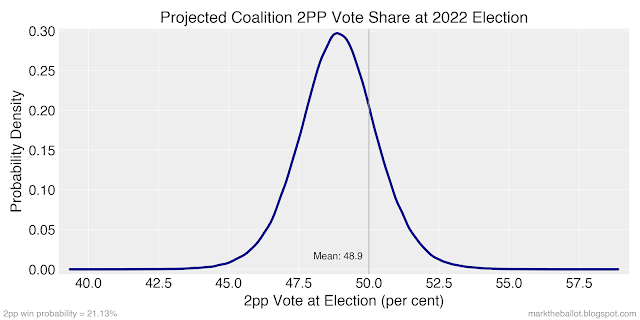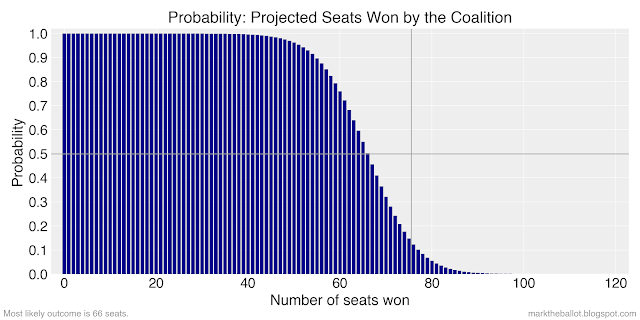Newspoll has just landed with a published two-party preferred (2pp) estimate of 53 to 47 per cent for Labor. This completes the polls for the 2022 Australian Federal Election. Rather than use published 2pp estimates, I calculate my own 2pp estimate for each pollster using the pollster's primary vote estimates and the preference flows from the previous election. May calculations for the latest polls are as follows.
This represents a small narrowing for Newspoll over the previous poll in the series. More generally we can see that the polls have tightened over the past 3 months.
The average 2pp estimate for the Coalition over the six polls highlighted above is 47.1 per cent. If this was repeated at the election tomorrow, almost certainly it would be a large win for an incoming Labor government. However, our experience with the 2019 election, and the substantial polling failure at that election urges caution.
When I look at all elections since 1983, I note that the polls have been more likely to be incorrect when they have Labor in front. Adjusting for the historic weakness in the polls, I expect Labor to attract something like 51.1 per cent of the 2pp vote at tomorrow's election. In terms of a highest density interval (analogous to a Bayesian confidence interval), I have labor with a 94 per cent probability that its 2pp election result will be between 48.3 per cent and 53.8 per cent. I expect the Coalition will achieve something like 48.9 per cent of the 2pp vote share. I have the Coalition's 94 per cent HDI in the range from 46.2 to 51.7 per cent.
The observation about the polls comes from a regression. I have now cross checked this regression as calculated in the Bayesian model (using Student's t distribution) with a simpler Gaussian regression from classical statistics over the same domain. The results are very close.
The other really interesting question this election is how many independents and minor party representatives will be elected. The polling estimate for primary votes for non-Liberal/Labor candidates is 29.1 per cent, up from 25.2 per cent in 2019. Translating the possible increase in primary votes to seats for independents is something that I have found difficult to model, and I suspect my most likely projection of 7 seats (an increase of 1) is an under estimate.
Agsin this is based on a regression, which I have now cross checked between the Bayesian model and a regression from classical statistics.

Then I have estimated how many seats both major parties would win if there
were no minor parties. I have then adjusted for the minor parties.
For completeness, here are the regressions that underpin this calculation.
My mean prediction is a Parliament with around 77 Labor seats, 66 Coalition seats and 7 Independents and minor parties. The astute will note that this sums to 150 when there 151 seats in Parliament, welcome to the joys of rounding.
In terms of the Parliamentary outcome, the model sees a 60.4 per cent probability of a Labor majority government, a 24.7 per cent probability of a hung parliament (where the eventual winner would need to be negotiated with the cross-bench), and a 14.8 per cent probability of a majority Coalition government.

















No comments:
Post a Comment